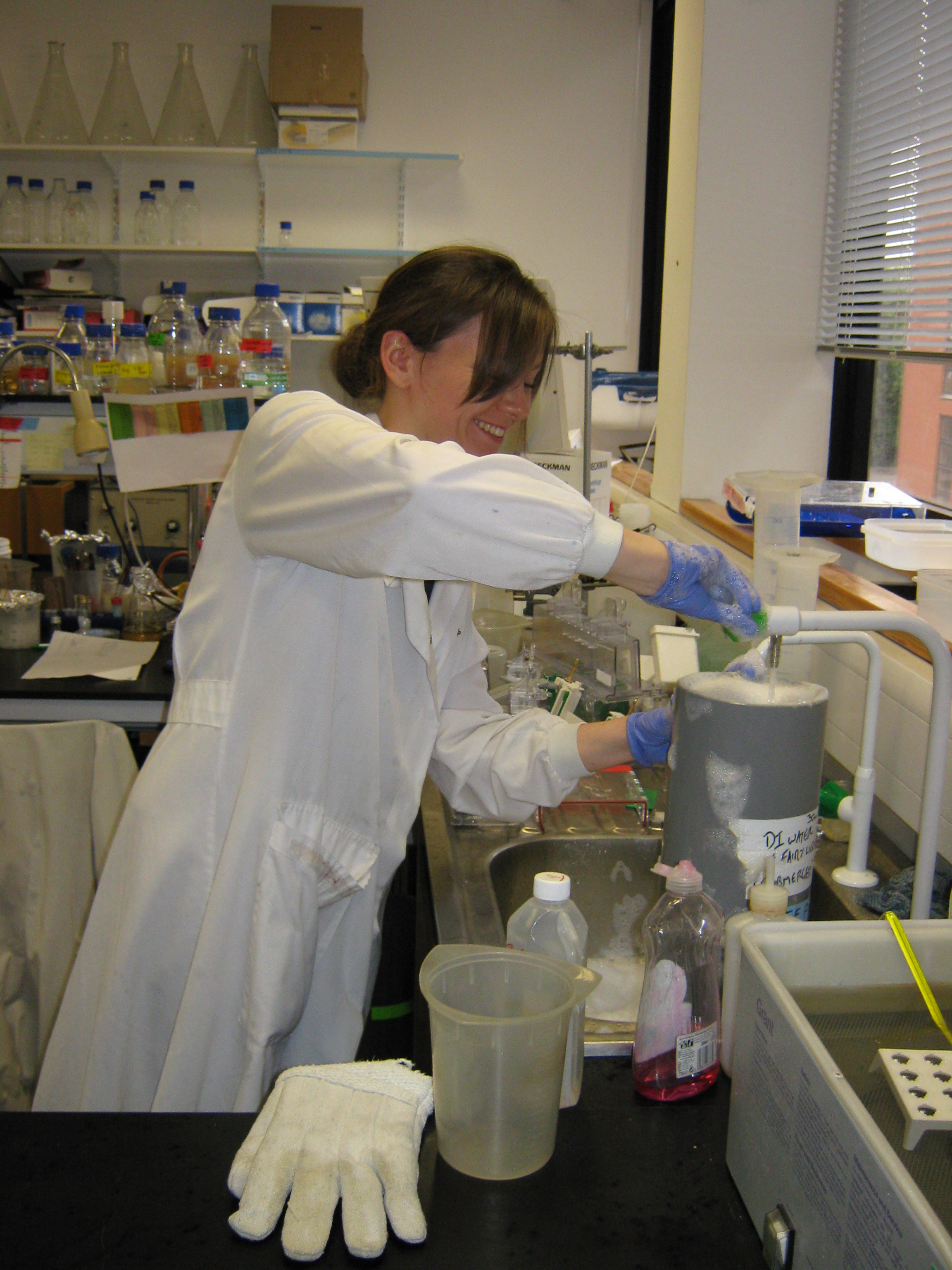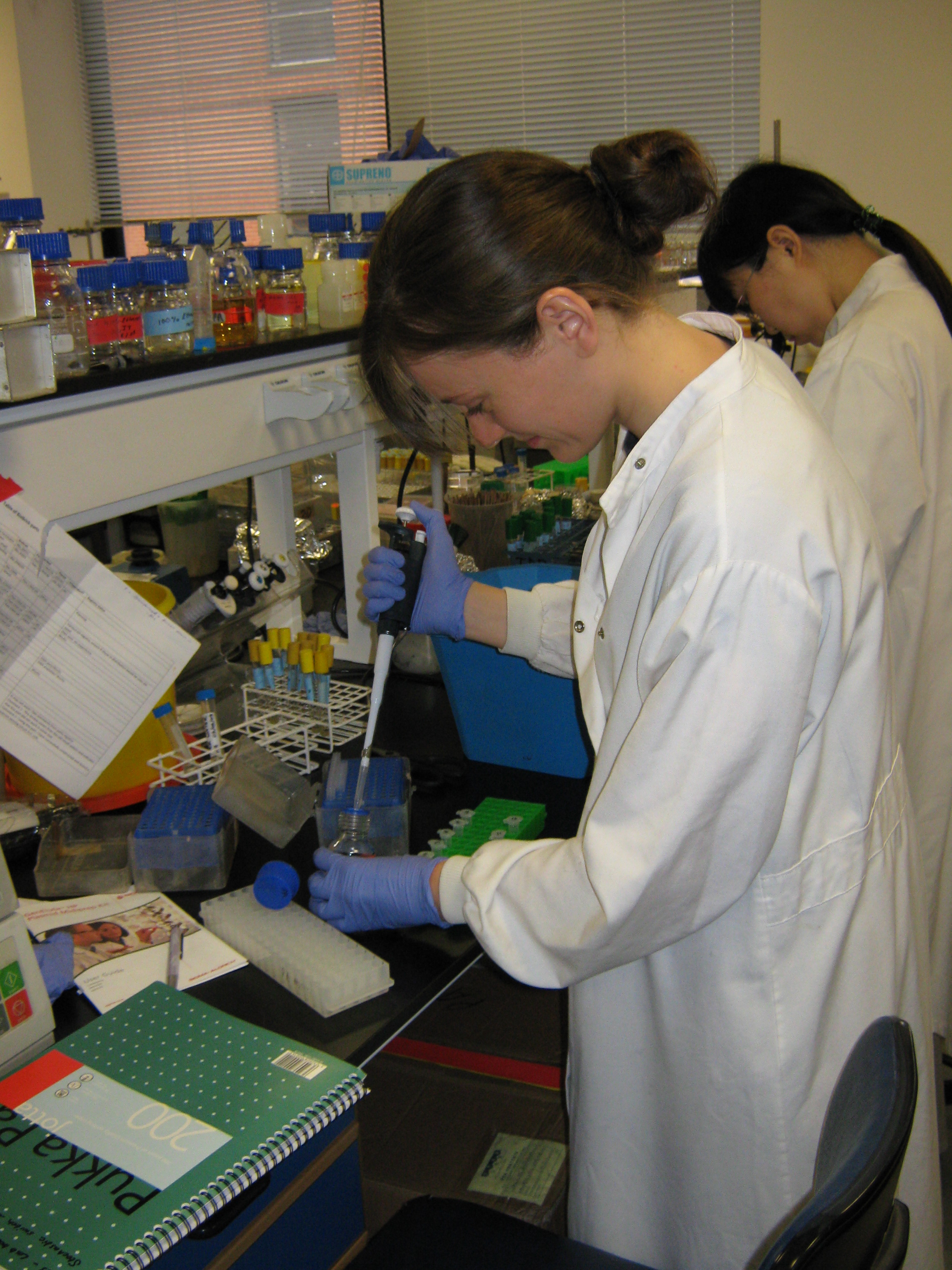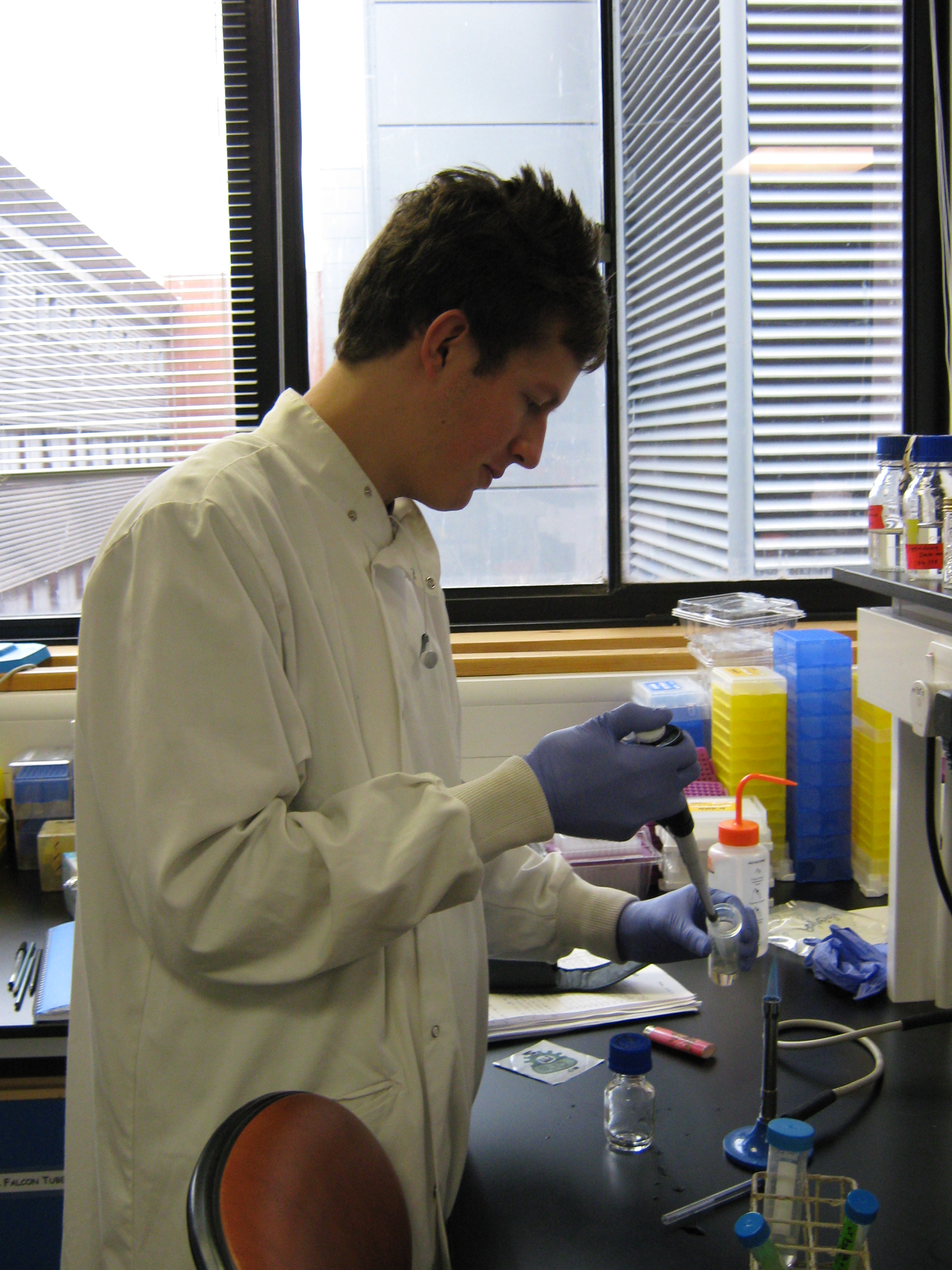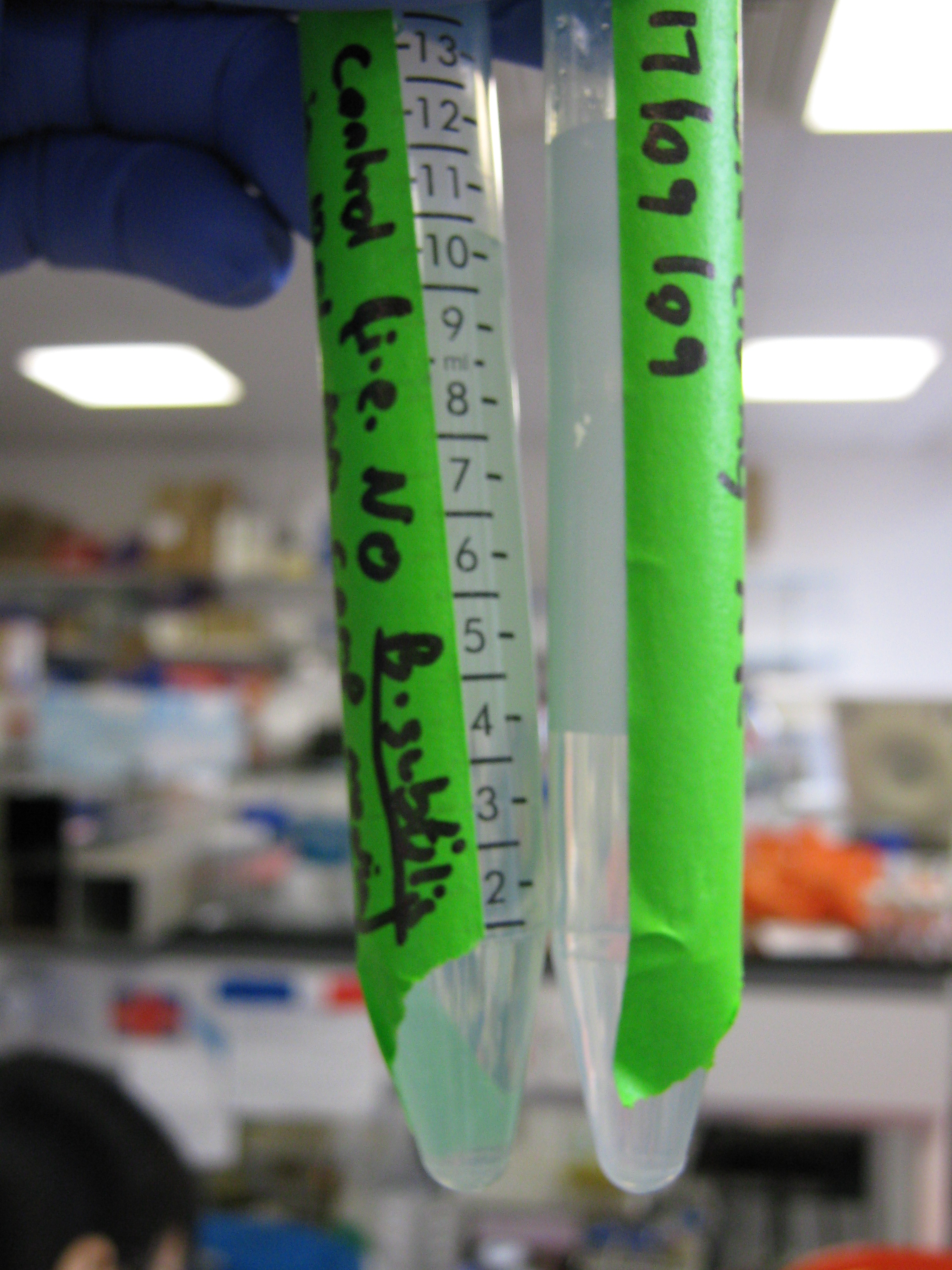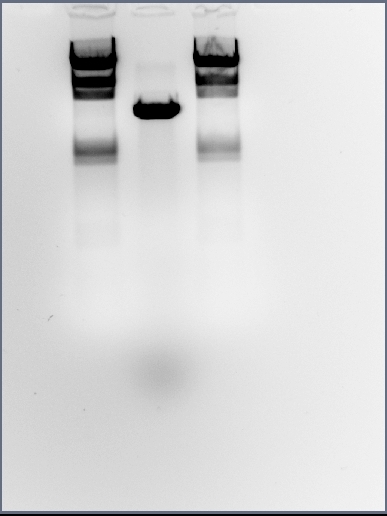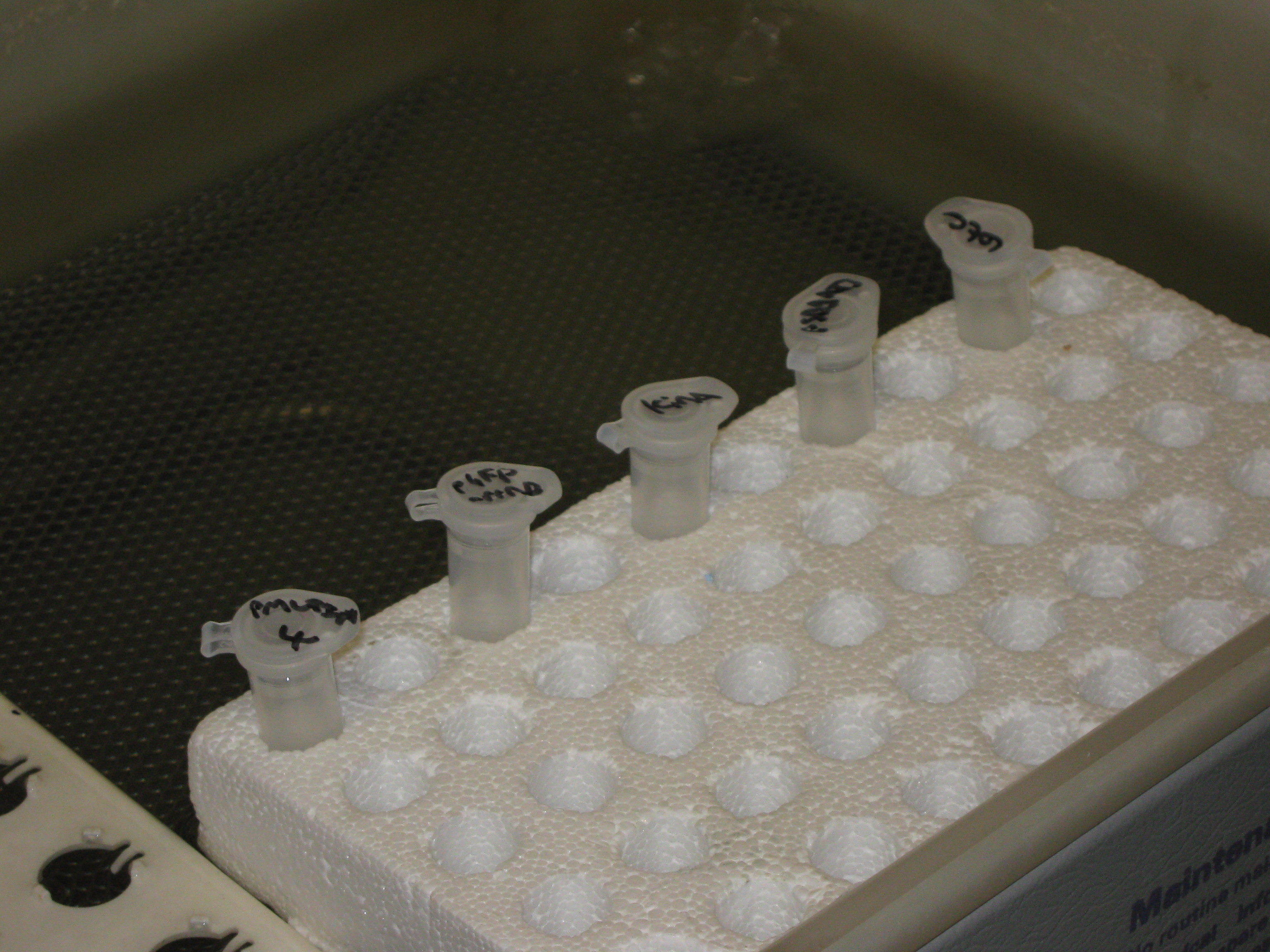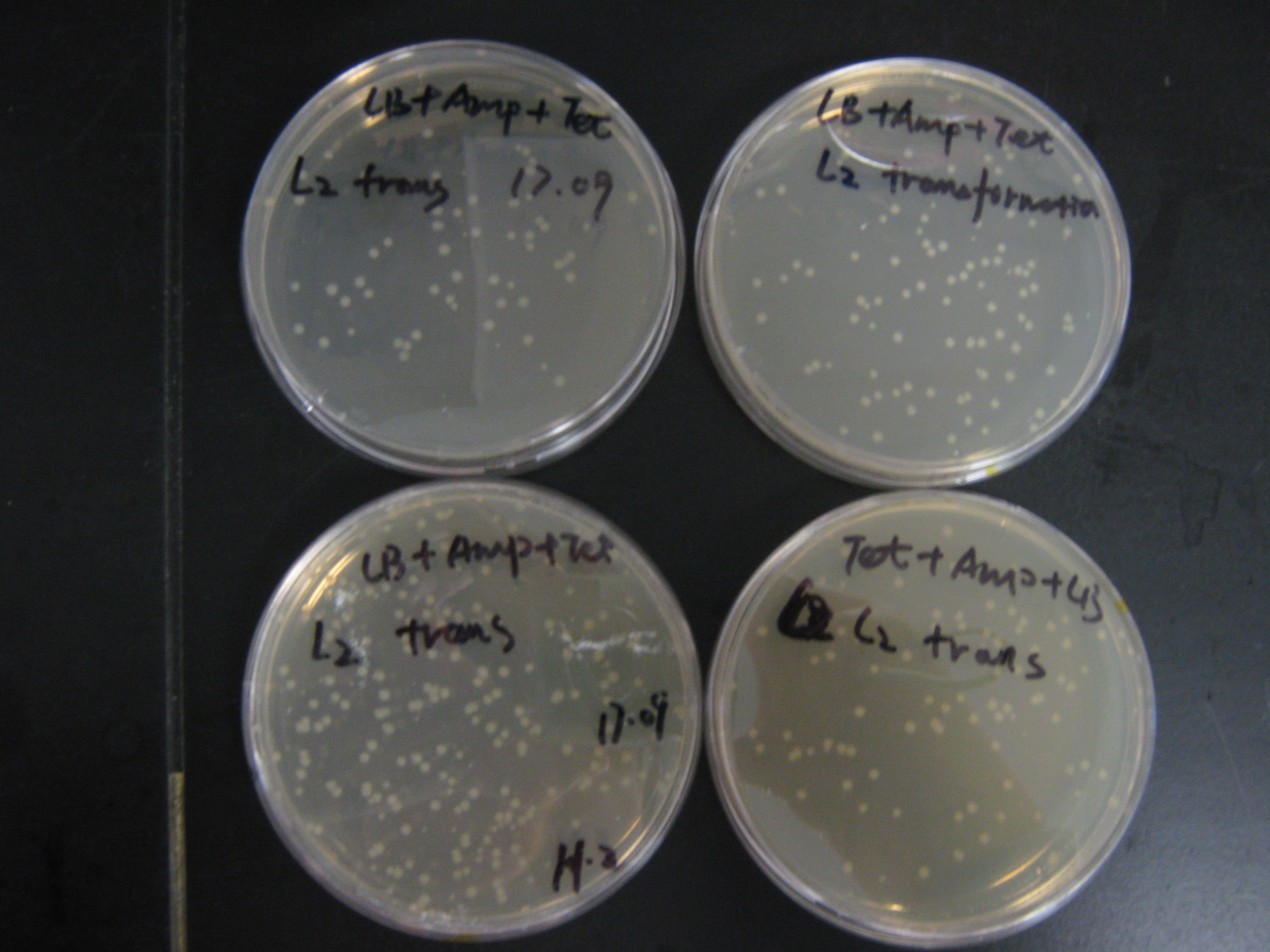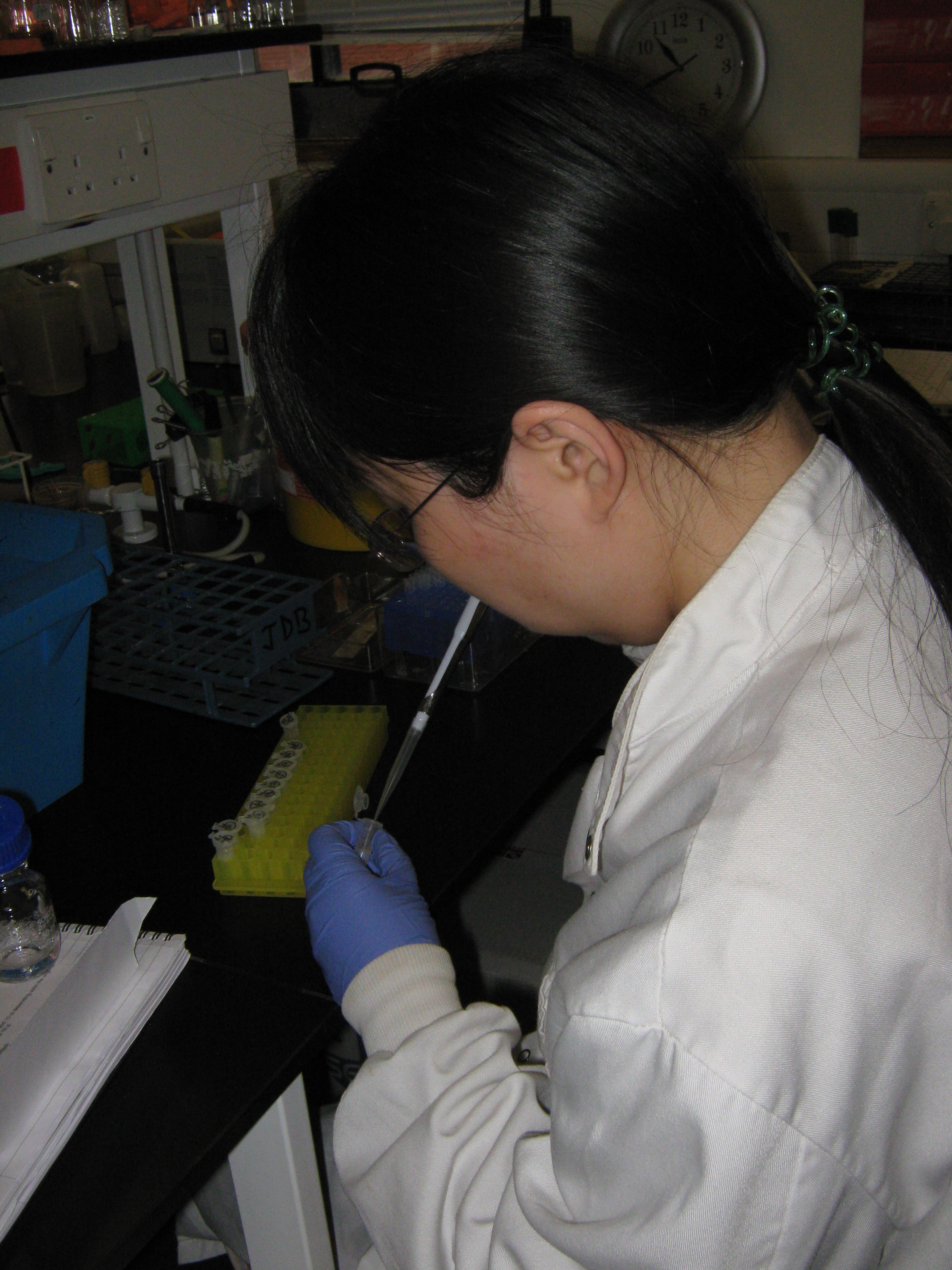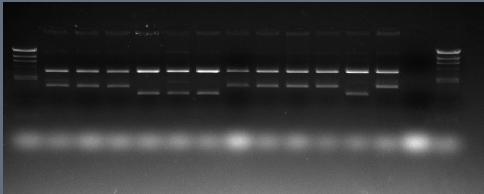Team:Newcastle/Labwork/18 September 2009
From 2009.igem.org
(→Stochastic switch team) |
(→Practical Outline) |
||
| (52 intermediate revisions not shown) | |||
| Line 5: | Line 5: | ||
[[Image:Team Newcastle 2009 iGEM ProbationaryP-Sign.PNG|50px|right]] | [[Image:Team Newcastle 2009 iGEM ProbationaryP-Sign.PNG|50px|right]] | ||
=Formal Lab Session - 18th September 2009= | =Formal Lab Session - 18th September 2009= | ||
| - | + | [[Image:Team Newcastle 2009 iGEM 18-09-09 IMG 1267.JPG|300px|center]] | |
| + | <br> | ||
| + | =<font color="Orange"><u>Overview</u></font>= | ||
| + | <font color="Orange"> | ||
| + | *[[#Stochastic Switch Team|Stochastic Switch Team]] '''- ''' | ||
| + | <br> | ||
| + | *[[#Metal Sensor Team|Metal Sensor Team]] '''- ''' | ||
| + | <br> | ||
| + | *[[#Sporulation Tuning/Chassis Team|Sporulation Tuning/Chassis Team]] '''- ''' | ||
| + | <br> | ||
| + | </font> | ||
| + | <br> | ||
| + | ==<u>Stochastic Switch Team</u>== | ||
| + | [[Image:Team Newcastle 2009 iGEM 18-09-09 IMG 1262.JPG|200px|right]] | ||
Today we did midipreps of the ara transformation and digested 10ul to run on a gel (EcoRI + PstI) Two bands could be seen one for the backbone and one correctly sied for the insert (~200bp) so this midiprep can be taken forward in order to do the ara-sspb double clone. | Today we did midipreps of the ara transformation and digested 10ul to run on a gel (EcoRI + PstI) Two bands could be seen one for the backbone and one correctly sied for the insert (~200bp) so this midiprep can be taken forward in order to do the ara-sspb double clone. | ||
| Line 15: | Line 28: | ||
* 80ul loading dye | * 80ul loading dye | ||
=400ul which was aliquoted into 4 tubes; 3 put in the freezer 1 in the fridge. | =400ul which was aliquoted into 4 tubes; 3 put in the freezer 1 in the fridge. | ||
| + | <br> | ||
| - | < | + | ==<u>Metal Sensor Team</u>== |
| - | + | ===Introduction=== | |
| - | + | ===Practical Outline=== | |
| - | | | + | [[Image:Team Newcastle 2009 iGEM 18-09-09 IMG 1257.JPG|200px|right]] |
| - | | | + | This is the initial list of tasks which need to be carried out by the end of the day: |
| + | <br> | ||
| + | # Start the ''Bacillus subtilis'' transformation process ([https://2009.igem.org/Team:Newcastle/Project/Labwork/OurProtocols/TransformBac#On_the_day_of_Bacillus_subtilis_transformations_.28starting_in_the_morning.29 "Day of transformation" steps] of protocol) in the morning. | ||
| + | # Design primers for checking ''B. subtilis'' ''cotC'' integration | ||
| + | # Plate out some TPA2 cells for production of competent ''DH5-alpha E. coli'' cells | ||
| + | # Run digests from yesterday (midi-prep digests) on gel | ||
| + | ## If successful transform ''B. subtilis'' with midi-prep DNA | ||
| + | ## If unsuccessful prepare another ligation attempt | ||
| + | # Carry out a second attempt at digesting the 5 midi-prep samples from the [https://2009.igem.org/Team:Newcastle/Labwork/11_September_2009#Midi-prep_cotC-GFP-smtA.2C_kinA.2C_pGFP-rrnB.2C_pMUTIN4_and_pSB1AT3 11/09/09 Lab Session], i.e. ''cotC-GFP-smtA'', ''kinA'', ''pGFP-rrnB'', ''pMUTIN4'' and ''pSB1AT3'' | ||
| + | <br> | ||
| + | |||
| + | ===Procedure=== | ||
| + | ====Starting ''Bacillus subtilis'' transformations==== | ||
| + | [[Image:Team Newcastle 2009 iGEM 18-09-09 IMG 1256.JPG|200px|thumb|The tube on the right, which contains ''B. subtilis'' cells (grown overnight) is slightly cloudier than the control]] | ||
| + | The team started the first stage of the ''Bacillus subtilis'' transformation process by carrying out the beginning steps of the [https://2009.igem.org/Team:Newcastle/Project/Labwork/OurProtocols/TransformBac#On_the_day_of_Bacillus_subtilis_transformations_.28starting_in_the_morning.29 "Day of transformation" section shown in the protocol]. If the midi-prep test digest analysis shows that the ligations and the transformation of ''cotC-GFP-smtA'' in the ''pMUTIN4'' plasmid have worked then some of the remaining midi-prep DNA can be used to transform ''B. subtilis'' when the time is right. | ||
| + | |||
| + | ====Designing primers for ''cotC'' BioBrick integration==== | ||
| + | It is key that if the team manage to transform ''Bacillus subtilis'' with the ''cotC-GFP-smtA'' BioBrick in ''pMUTIN4'' plasmid, they can determine that the BioBrick has successfully integrated into the ''B. subtilis'' genome. We have designed the BioBrick so that it integrates within the ''cotC'' gene of the ''B. subtilis'' genome so any primers designed should flank this region. Unfortunately, due to time restrictions, we didn't manage to carry this step out; it will be carried out another day. | ||
| + | |||
| + | ====Plating out TPA2 cells==== | ||
| + | It has been noted that the stock of competent ''DH5-alpha'' ''E. coli'' cells stored in the -80C freezer has been greatly reduced. To generate some more competent ''E. coli'' cells, some TPA2 cells (''DH5-alpha E. coli'') from the stocks freezer were taken and spread on an LB + agar plate. This is to fulfil the first step of the "Pre-culture" stage in the [https://2009.igem.org/Team:Newcastle/Project/Labwork/PhilsProtocols#Preparing_Competent_E.coli_cells_for_Heat_Shock "Preparing Competent Cells" protocol]. The plate will then be grown overnight in the 37C incubator. | ||
| + | |||
| + | ====Analysing midi-prep digests==== | ||
| + | [[Image:Team Newcastle 2009 iGEM Geldoc 2009-09-18 13hr 51min.jpg|300px|center]] | ||
| + | <br> | ||
| + | The midi-prep digest, which we are analysing today, was carried out in [https://2009.igem.org/Team:Newcastle/Labwork/17_September_2009#b.29_Digesting_the_midi-preps yesterday's lab session]. The team hopes that the midi-prep DNA is that of ''cotC-GFP-smtA'' ligated into ''pMUTIN4'' plasmid and only an analytical digest will determine this. | ||
| + | |||
| + | <font color="purple"><u>'''Just as a recap:'''</u> we had attempted to ligate the ''cotC'' BioBrick into ''pMUTIN4'' and had attempted to transform ''DH5-alpha E. coli'' with this product. Several colonies were found on the LB + chloramphenicol plate the trasnformants had been plated onto which suggested both the ligations and the transformations had worked well. Mini-preps were then carried out for 12 colonies in the [https://2009.igem.org/Team:Newcastle/Labwork/16_September_2009#a.29_Mini-preps_of_cotC-GFP-smtA_E._coli_transformants 16/09/09 Lab Session] and digested. When ran on gel, the 2 bands created did not match the expected sizes but there was consistency for most of the samples. This led us to think that it was the restriction enzymes to blame and ruled out contamination. | ||
| + | |||
| + | Based on this decision, the Metal Sensing team conducted a midi-prep on colony 8 LB culture (seen as colony 8 had the clearest bands) and had digested the DNA (see the [https://2009.igem.org/Team:Newcastle/Labwork/17_September_2009#1.29_Midi-prep_of_potential_cotC-GFP-smtA_transformant_E._coli_cells 17/09/09 Lab Session]). The team then attempted to run 10ul of the digest on agrose gel through DNA gel electrophoresis but the DNA ladder was faulty and the bands seemed faint. Today's midi-prep analysis is a second attempt of this procedure. | ||
| + | </font> | ||
| + | |||
| + | It can be seen that the gel photograph shows some erroneous results; there is only one band in sight when there should be two (''pMUTIN4'' and ''cotC-GFP-smtA'' bands) and the band formed lies just underneath the 4,361 band from the ''HindIII'' DNA ladder. This size neither matches ''pMUTIN4'' or ''cotC-GFP-smtA'' indicating a huge error. | ||
| + | |||
| + | =====Conclusion===== | ||
| + | We will have to abandon the potential ''Bacillus subtilis'' transformations and consider carrying out a second attempt at ligating together ''pMUTIN4'' and ''cotC-GFP-smtA''. | ||
| + | <br> | ||
| + | |||
| + | ====Analysing ''cotC'', ''kinA'', ''pGFP-rrnB'', ''pMUTIN4'' and ''pSB1AT3'' midi-preps==== | ||
| + | [[Image:Team Newcastle 2009 iGEM 18-09-09 IMG 1268.JPG|350px|center]] | ||
| + | <br> | ||
| + | Today, we only got as far as digesting the five midi-prep samples with restriction enzymes (this should linearise the plasmids) - tomorrow the team will run products on gel. The restriction digests were allowed to run for 1 hour at 37C (in waterbath). The contents of the digest reactions were as follows: | ||
| + | <br> | ||
| + | {| border="1" | ||
| + | |+ Contents of restriction enzyme digests | ||
| + | ! !! DNA (ul) !! ''EcoRI'' (ul) !! ''PstI'' (ul) !! ''BamHI'' (ul) !! Buffer (ul) !! Water (ul) | ||
| + | |- | ||
| + | ! ''cotC-GFP-smtA'' | ||
| + | | 10 || 1 || 1 || 0 || 2 || 6 | ||
| + | |- | ||
| + | ! ''kinA'' | ||
| + | | 10 || 1 || 1 || 0 || 2 || 6 | ||
| + | |- | ||
| + | ! ''pGFP-rrnB'' | ||
| + | | 10 || 1 || 0 || 0 || 2 || 7 | ||
| + | |- | ||
| + | ! ''pMUTIN4'' | ||
| + | | 10 || 0 || 0 || 1 || 2 || 7 | ||
| + | |- | ||
| + | ! ''pSB1AT3'' | ||
| + | | 10 || 1 || 1 || 0 || 2 || 6 | ||
| + | |- | ||
|} | |} | ||
| - | </center> | + | Once the digests were completed, the samples were placed in the -20C freezer for storage. |
| + | <br> | ||
| + | |||
| + | ===New Tasks=== | ||
| + | In light of the ligation/transformation not working, the team needs to start again with the ''cotC-GFP-smtA'' work. This involves carrying out a PCR amplification of the ''cotC'' BioBrick, digesting both ''cotC'' and ''pMUTIN4'', ligating the two fragments together and then using this DNA to transform ''E. coli'' cells. | ||
| + | <br> | ||
| + | Today, we will do the following: | ||
| + | <br> | ||
| + | * Carry out a PCR amplification of the ''cotC-GFP-smtA'' BioBrick (which is found within the ''pMK-RQ'' plasmid) using primers ''cotC_forward'' and ''cotC_reverse'' | ||
| + | <br> | ||
| + | ====PCR amplification of ''cotC-GFP-smtA''==== | ||
| + | <br> | ||
| + | ==<u>Sporulation Tuning/Chassis Team</u>== | ||
| + | [[Image:Team Newcastle 2009 iGEM 18-09-09 IMG 1271.JPG|350px|center]] | ||
| + | <br> | ||
| + | ===Introduction=== | ||
| + | * We cultured two sets of transformation cells yesterday, two Mini prep need to be processed today. | ||
| + | * After Mini Prep, we digested those plasmid to find the strain which contains right clone. | ||
| + | * Continued with yesterday's PCR result, a PCR clean-up process was carried out today. | ||
| + | <br> | ||
| + | |||
| + | ===Experiment procedure=== | ||
| + | [[Image:Team Newcastle 2009 iGEM 18-09-09 IMG 1259.JPG|200px|right]] | ||
| + | ==== Mini Prep for L1 and L2 ==== | ||
| + | * Followed the Phil's Mini Prep protocal. | ||
| + | |||
| + | ==== Digest the Mini Prep result ==== | ||
| + | * Prepare the digest reaction. | ||
| + | dd H2O 7ul | ||
| + | 10X fast digest buffer 2ul | ||
| + | Fast enzyme 1 0.5ul | ||
| + | Fast enzyme 2 0.5ul | ||
| + | Mini Prep Plasmid 10ul | ||
| + | ------------------------------ | ||
| + | 20ul | ||
| + | * Incubate 1 hour at 37 degree. | ||
| + | |||
| + | * For digestion of L1 Mini Prep result: | ||
| + | enzyme 1 EcoRI | ||
| + | enzyme 2 SpeI | ||
| + | * For digestion of L2 Mini Prep result: | ||
| + | enzyme 1 XbaI | ||
| + | enzyme 2 SpeI | ||
| + | Control plasmid : pSB1AT3:sleB | ||
| + | |||
| + | ==== Run the digested result on 0.8% agarose gel ==== | ||
| + | * 2ul stop buffer added before loading sample | ||
| + | |||
| + | ===Conclusion=== | ||
| + | * From the gel picture. | ||
| + | L1: all stains worked well except No.10. | ||
| + | L2: Strain No.4,5,6,11 were not the right clone. | ||
| + | |||
| + | <br> | ||
| + | [[Image:Team_newcastle_2009_hanny_geldoc_180909_1.jpg |400px|thumb|center|L1: cwlJ transformation ]] | ||
| + | |||
| + | [[Image:Team_newcaslte_2009_hanny_geldoc_180909_2.jpg |400px|thumb|center |L2: cwlJ and sleB double clone ]] | ||
| + | |||
| + | ===Further plan=== | ||
| + | * Culture the right strain for Midi prep of plasmid. | ||
| + | * PCR sleB+cwlJ part and ligate to pMutin4 plasmid. | ||
| + | * Midi Prep L1 and L2 strain. | ||
| + | |||
| + | {{:Team:Newcastle/Project/Labwork/CalTemplate}} | ||
{{:Team:Newcastle/Footer}} | {{:Team:Newcastle/Footer}} | ||
{{:Team:Newcastle/Right}} | {{:Team:Newcastle/Right}} | ||
Latest revision as of 17:02, 21 October 2009
Formal Lab Session - 18th September 2009
Overview
Stochastic Switch Team
Today we did midipreps of the ara transformation and digested 10ul to run on a gel (EcoRI + PstI) Two bands could be seen one for the backbone and one correctly sied for the insert (~200bp) so this midiprep can be taken forward in order to do the ara-sspb double clone.
Today we also made up some fresh DNA ladder as we have had problems with degradation.
- 40ul of 500ug/ml promega lambda HindIII digest (20ug in total)
- 280ul H2O
- 80ul loading dye
=400ul which was aliquoted into 4 tubes; 3 put in the freezer 1 in the fridge.
Metal Sensor Team
Introduction
Practical Outline
This is the initial list of tasks which need to be carried out by the end of the day:
- Start the Bacillus subtilis transformation process ("Day of transformation" steps of protocol) in the morning.
- Design primers for checking B. subtilis cotC integration
- Plate out some TPA2 cells for production of competent DH5-alpha E. coli cells
- Run digests from yesterday (midi-prep digests) on gel
- If successful transform B. subtilis with midi-prep DNA
- If unsuccessful prepare another ligation attempt
- Carry out a second attempt at digesting the 5 midi-prep samples from the 11/09/09 Lab Session, i.e. cotC-GFP-smtA, kinA, pGFP-rrnB, pMUTIN4 and pSB1AT3
Procedure
Starting Bacillus subtilis transformations
The team started the first stage of the Bacillus subtilis transformation process by carrying out the beginning steps of the "Day of transformation" section shown in the protocol. If the midi-prep test digest analysis shows that the ligations and the transformation of cotC-GFP-smtA in the pMUTIN4 plasmid have worked then some of the remaining midi-prep DNA can be used to transform B. subtilis when the time is right.
Designing primers for cotC BioBrick integration
It is key that if the team manage to transform Bacillus subtilis with the cotC-GFP-smtA BioBrick in pMUTIN4 plasmid, they can determine that the BioBrick has successfully integrated into the B. subtilis genome. We have designed the BioBrick so that it integrates within the cotC gene of the B. subtilis genome so any primers designed should flank this region. Unfortunately, due to time restrictions, we didn't manage to carry this step out; it will be carried out another day.
Plating out TPA2 cells
It has been noted that the stock of competent DH5-alpha E. coli cells stored in the -80C freezer has been greatly reduced. To generate some more competent E. coli cells, some TPA2 cells (DH5-alpha E. coli) from the stocks freezer were taken and spread on an LB + agar plate. This is to fulfil the first step of the "Pre-culture" stage in the "Preparing Competent Cells" protocol. The plate will then be grown overnight in the 37C incubator.
Analysing midi-prep digests
The midi-prep digest, which we are analysing today, was carried out in yesterday's lab session. The team hopes that the midi-prep DNA is that of cotC-GFP-smtA ligated into pMUTIN4 plasmid and only an analytical digest will determine this.
Just as a recap: we had attempted to ligate the cotC BioBrick into pMUTIN4 and had attempted to transform DH5-alpha E. coli with this product. Several colonies were found on the LB + chloramphenicol plate the trasnformants had been plated onto which suggested both the ligations and the transformations had worked well. Mini-preps were then carried out for 12 colonies in the 16/09/09 Lab Session and digested. When ran on gel, the 2 bands created did not match the expected sizes but there was consistency for most of the samples. This led us to think that it was the restriction enzymes to blame and ruled out contamination.
Based on this decision, the Metal Sensing team conducted a midi-prep on colony 8 LB culture (seen as colony 8 had the clearest bands) and had digested the DNA (see the 17/09/09 Lab Session). The team then attempted to run 10ul of the digest on agrose gel through DNA gel electrophoresis but the DNA ladder was faulty and the bands seemed faint. Today's midi-prep analysis is a second attempt of this procedure.
It can be seen that the gel photograph shows some erroneous results; there is only one band in sight when there should be two (pMUTIN4 and cotC-GFP-smtA bands) and the band formed lies just underneath the 4,361 band from the HindIII DNA ladder. This size neither matches pMUTIN4 or cotC-GFP-smtA indicating a huge error.
Conclusion
We will have to abandon the potential Bacillus subtilis transformations and consider carrying out a second attempt at ligating together pMUTIN4 and cotC-GFP-smtA.
Analysing cotC, kinA, pGFP-rrnB, pMUTIN4 and pSB1AT3 midi-preps
Today, we only got as far as digesting the five midi-prep samples with restriction enzymes (this should linearise the plasmids) - tomorrow the team will run products on gel. The restriction digests were allowed to run for 1 hour at 37C (in waterbath). The contents of the digest reactions were as follows:
| DNA (ul) | EcoRI (ul) | PstI (ul) | BamHI (ul) | Buffer (ul) | Water (ul) | |
|---|---|---|---|---|---|---|
| cotC-GFP-smtA | 10 | 1 | 1 | 0 | 2 | 6 |
| kinA | 10 | 1 | 1 | 0 | 2 | 6 |
| pGFP-rrnB | 10 | 1 | 0 | 0 | 2 | 7 |
| pMUTIN4 | 10 | 0 | 0 | 1 | 2 | 7 |
| pSB1AT3 | 10 | 1 | 1 | 0 | 2 | 6 |
Once the digests were completed, the samples were placed in the -20C freezer for storage.
New Tasks
In light of the ligation/transformation not working, the team needs to start again with the cotC-GFP-smtA work. This involves carrying out a PCR amplification of the cotC BioBrick, digesting both cotC and pMUTIN4, ligating the two fragments together and then using this DNA to transform E. coli cells.
Today, we will do the following:
- Carry out a PCR amplification of the cotC-GFP-smtA BioBrick (which is found within the pMK-RQ plasmid) using primers cotC_forward and cotC_reverse
PCR amplification of cotC-GFP-smtA
Sporulation Tuning/Chassis Team
Introduction
- We cultured two sets of transformation cells yesterday, two Mini prep need to be processed today.
- After Mini Prep, we digested those plasmid to find the strain which contains right clone.
- Continued with yesterday's PCR result, a PCR clean-up process was carried out today.
Experiment procedure
Mini Prep for L1 and L2
- Followed the Phil's Mini Prep protocal.
Digest the Mini Prep result
- Prepare the digest reaction.
dd H2O 7ul
10X fast digest buffer 2ul
Fast enzyme 1 0.5ul
Fast enzyme 2 0.5ul
Mini Prep Plasmid 10ul
------------------------------
20ul
- Incubate 1 hour at 37 degree.
- For digestion of L1 Mini Prep result:
enzyme 1 EcoRI enzyme 2 SpeI
- For digestion of L2 Mini Prep result:
enzyme 1 XbaI enzyme 2 SpeI Control plasmid : pSB1AT3:sleB
Run the digested result on 0.8% agarose gel
- 2ul stop buffer added before loading sample
Conclusion
- From the gel picture.
L1: all stains worked well except No.10. L2: Strain No.4,5,6,11 were not the right clone.
Further plan
- Culture the right strain for Midi prep of plasmid.
- PCR sleB+cwlJ part and ligate to pMutin4 plasmid.
- Midi Prep L1 and L2 strain.
|
| |||||||||||||||||||||||||||||||||||||||||||||||||||||||||||||||||||||||||||||||||||||||||||||||||
|
| |||||||||||||||||||||||||||||||||||||||||||||||||||||||||||||||||||||||||||||||||||||||||||||
News
Events
- 20 – 21 June 2009 - Europe workshop (London)
- 23 – 24 June 2009 - UK iGEM meetup (Edinburgh)
- 23 October Practice Presentation (Newcastle)
- 23 October T-shirts are ready
- 27 October Practice Presentation (Sunderland)
- 27 October Poster is ready
- 30 October – 2 November 2009 - Jamboree (Boston)
Social Net
- Newcastle iGEM Twitter
- [http://www.facebook.com/home.php#/group.php?gid=131709337641 Newcastle on Facebook]
- [http://www.youtube.com/user/newcastle2009igem Newcastle Youtube Channel]
 "
"

